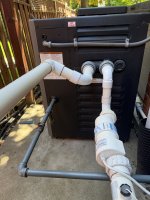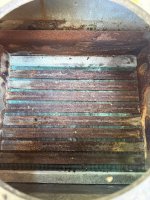- Jun 12, 2020
- 8
- Pool Size
- 75000
- Surface
- Vinyl
- Chlorine
- Salt Water Generator
- SWG Type
- Hayward Aqua Rite (T-15)
Hey all,
I'm looking for some advice (I'll have multiple questions here). I currently have a Raypak 266k BTU Heater, Model Number: P-R266A-EN-C (S/N: 170434606). This year, when opening up my pool, I had some issue with the heater starting up. I got it to start, but the flame kept going out. I called a company to come out to take a look, and they want to replace the ignition system. I agreed to this service, however, once they came out, and went to install this new part, they took out the current burner tray assemble, and it appears to be completely rusted out / unsafe (to which I agree):

The crew that came out said that based on how it has corroded it's likely the heater exchange at one point had a serious leak, but he said he sees no signs of that leak right now. This company said they would quote me for a repair, but instead quoted me for a new unit. Without getting into the details, the quote was, in my opinion, ridiculously too high. So this leads me to my questions, and please note, I live in Canada, so all prices will be in CAD.
1 -> Looking at this picture, would it be worth it to replace the burner assembly? Based on me looking online for parts / prices, it may cost over $1000 in parts, plus labour to fix. (It would be a new burner tray assembly, plus ignition, plus potentially other components).
2 -> If I do need a new unit, I can probably get one shipped for around $3000. I feel if I get the EXACT same unit, I can probably install it myself. All electrical, plumbing, and gas piping is already installed and connected, so I figure all I would need to do is swap them. The plumbing looks like it just unscrews from the heaters connections, same with the electrical. Inside of the unit, I see the gas is connected via a union, so I would just need to unscrew that one piece and reconnected it in the new unit. Once installed, and before I turn it on, I would have to get a licensed gas inspector to came take a look at the install / piping to ensure it's safe (I don't want to risk it).
3 -> If it is not advised to attempt the install myself, and I should get a professional company out to do the install, would it be recommended to stay with the 266k BTU unit, or should I opt to get a higher BTU unit (400k BTU for example)? My pool is about 75k litres which is about 16.5k gallons (I can give more pool details if required).
Thanks everyone for your opinions!
I'm looking for some advice (I'll have multiple questions here). I currently have a Raypak 266k BTU Heater, Model Number: P-R266A-EN-C (S/N: 170434606). This year, when opening up my pool, I had some issue with the heater starting up. I got it to start, but the flame kept going out. I called a company to come out to take a look, and they want to replace the ignition system. I agreed to this service, however, once they came out, and went to install this new part, they took out the current burner tray assemble, and it appears to be completely rusted out / unsafe (to which I agree):

The crew that came out said that based on how it has corroded it's likely the heater exchange at one point had a serious leak, but he said he sees no signs of that leak right now. This company said they would quote me for a repair, but instead quoted me for a new unit. Without getting into the details, the quote was, in my opinion, ridiculously too high. So this leads me to my questions, and please note, I live in Canada, so all prices will be in CAD.
1 -> Looking at this picture, would it be worth it to replace the burner assembly? Based on me looking online for parts / prices, it may cost over $1000 in parts, plus labour to fix. (It would be a new burner tray assembly, plus ignition, plus potentially other components).
2 -> If I do need a new unit, I can probably get one shipped for around $3000. I feel if I get the EXACT same unit, I can probably install it myself. All electrical, plumbing, and gas piping is already installed and connected, so I figure all I would need to do is swap them. The plumbing looks like it just unscrews from the heaters connections, same with the electrical. Inside of the unit, I see the gas is connected via a union, so I would just need to unscrew that one piece and reconnected it in the new unit. Once installed, and before I turn it on, I would have to get a licensed gas inspector to came take a look at the install / piping to ensure it's safe (I don't want to risk it).
3 -> If it is not advised to attempt the install myself, and I should get a professional company out to do the install, would it be recommended to stay with the 266k BTU unit, or should I opt to get a higher BTU unit (400k BTU for example)? My pool is about 75k litres which is about 16.5k gallons (I can give more pool details if required).
Thanks everyone for your opinions!








